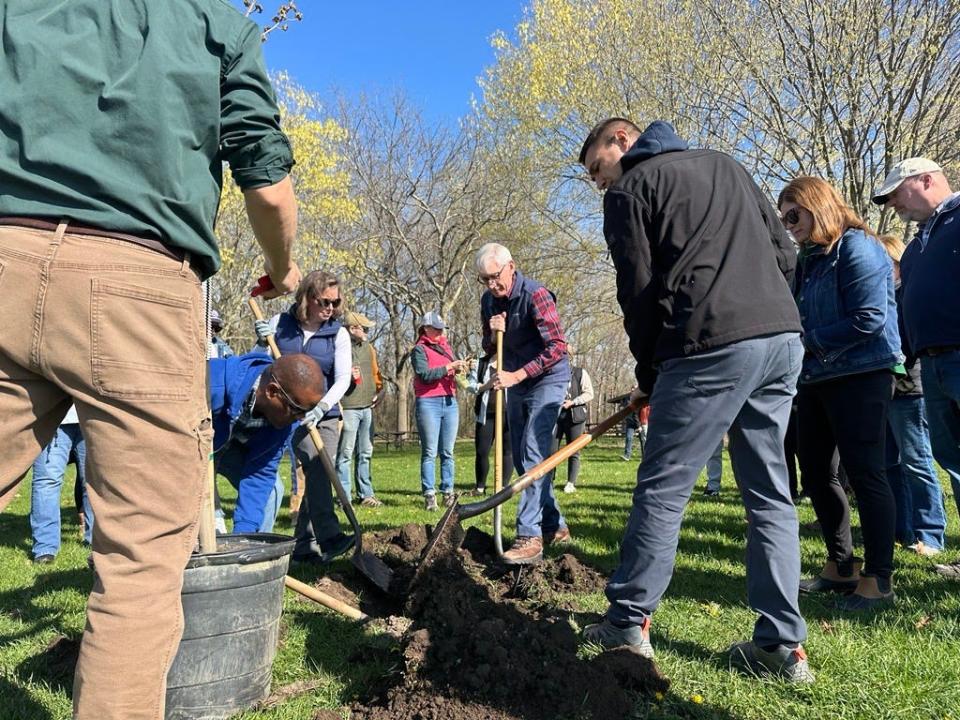Gov. Tony Evers increases Wisconsin's commitment to plant 100 million trees by 2030
WAUNAKEE — On the shore of Lake Mendota at the state park named for the holiday's founder, Gov. Tony Evers on Earth Day signed an executive order pledging that the state will plant 100 million trees by the end of 2030 — an increase from the state's initial commitment of 75 million.
Wisconsin first joined the global Trillion Trees Initiative, led by the World Economic Forum and American Forests, with an Evers executive order in 2021. The order also included a pledge to conserve 125,000 acres of forestland by 2030.
The governor told cabinet members and state employees gathered at Governor Nelson State Park on Monday that he was a freshman at the University of Wisconsin-Madison when Earth Day was first celebrated in 1970 — a result of Wisconsin's former governor and senator Gaylord Nelson's advocacy.
"We actually, at the UW-Madison campus, had a full day of Earth Day, and professors and others had teach-ins, and it was really extraordinary," Evers told reporters after planting a tree with a group. "It's something I still remember to this day."
Here's what to know about Earth Day and the governor's tree-planting pledge.

How many trees have been planted since the 2021 pledge?
The state has planted more than 32 million trees since Evers issued his 2021 executive order.
According to an annual report from the state Department of Natural Resources, more than 9.8 million trees were planted and more than 3,000 acres of forestland were conserved last year. More than two-thirds of seedlings were provided by the DNR. About 22% were planted on private lands. and about 19% were planted on DNR, federal, tribal and other public lands. About 100,000 were planted in county forests, 31,000 in school forests and more than 37,000 were given to elementary school students last Arbor Day.
Since the early 1900s, the DNR's reforestation program has supplied landowners in the state with more than 1.6 billion seedlings.
Private nurseries partnering with the DNR supplied more than 3 million tree for conservation purposes, in addition to trees supplied by private nurseries for landscaping.
What will 100 million trees do for the environment?
According to the U.S. Department of Agriculture, a mature tree can store and exchange about 48 pounds of carbon dioxide from the atmosphere in one year. That means 100 million mature trees could store and exchange an expected 4.8 billion pounds of carbon dioxide per year.
The state's updated goal will also contribute to the Great Lakes St. Lawrence Governors and Premiers’ bipartisan pledge to plant 250 million trees by 2033.
How many trees did Wisconsin plant in a normal year?
In the years before Wisconsin joined the Trillion Trees Initiative, the DNR nursery had distributed about 2.5 million to 3 million seedlings per year.
Why do we celebrate Earth Day?
While in the Senate, Nelson was frustrated by the lack of federal action on pressing environmental issues during. He advocated for "environmental teach-ins" at schools to prompt change, and on April 22, 1970, 20 million people, showed up at events across the country in support of a cleaner environment.
In the following years, Congress passed the Clean Water Acts, Clean Air Act, the National Wild and Scenic Rivers Act, the Federal Pesticides Act, the Environmental Education Act, the National Hiking Trails and the National Scenic Trails Acts. Under President Richard Nixon, the federal government also created the Environmental Protection Agency.
Earth Day has since become an international event celebrated in more than 180 countries.
What does Evers hope will come from the tree-planting effort?
"Certainly all the stuff that the trees do is right on target. They take carbon dioxide and release oxygen to the air and sequester the carbon into the ground. So they are doing their part," Evers said when asked about his hopes for the new tree-planting commitment. "I think we as human beings can do a little bit better. We're working on it. We have (electric vehicle charing stations) going now, and as people participate in purchasing those vehicles, that's going to make a difference as well as, obviously, our big, big issues around making sure that we're getting enough solar energy in our system and making that happen. So, we're on the right track, but we have a long, long way to go."
Laura Schulte of the Milwaukee Journal Sentinel contributed.
Jessie Opoien can be reached at [email protected].
This article originally appeared on Milwaukee Journal Sentinel: What to know about Wisconsin's effort to plant 100 million trees
Solve the daily Crossword

